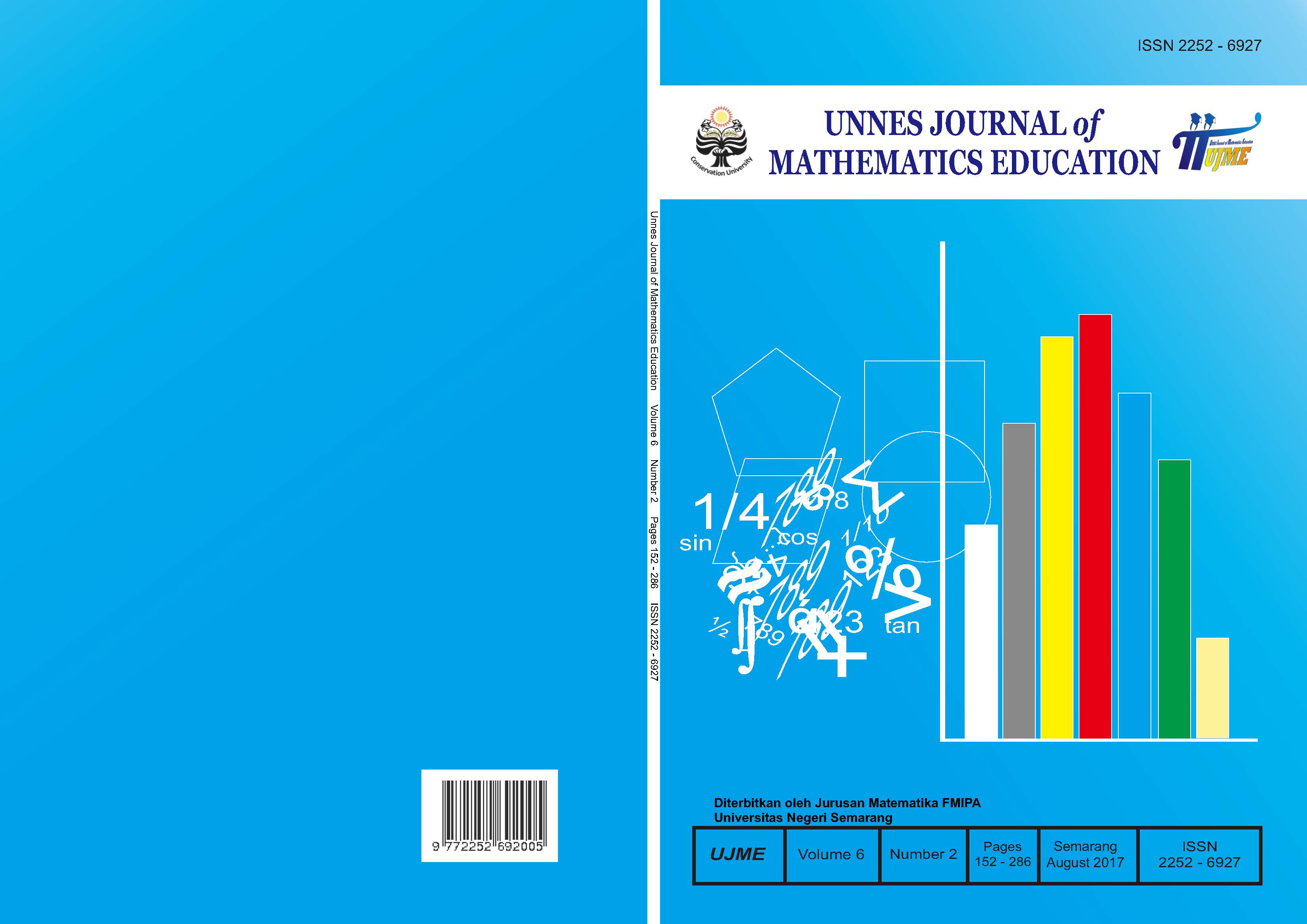Mathematical Creative Thinking Ability of the Seventh Grade Students in Terms of Learning Styles to the Preview-Question-Read-Reflect-Recite-Review (PQ4R) Learning
##plugins.themes.academic_pro.article.main##
Abstract
The purpose of this study are: (1) to know the effectiveness of PQ4R learning model in improving the creative thinking skills of the learners; (2) to know the classifications of the learners based on the levels of creative thinking skills; and (3) to describe the misconception which hampers the creative thinking skills at low level in from the learning styles of the learners. The population in this study is the seventh grade students of SMP N 21 Semarang. The method in this study is mixed method research. Quantitative data analysis uses t-test, z-test, and normalized gain test. Analysis of qualitative data using data reduction stages, data presentation, and conclusions. The results show: (1) PQ4R learning model is effective in improving the creative thinking ability of the learners; (2) the classifications of the learners based on the levels of creative thinking ability which have variations the are many of the learners who are different in each level; and (3) misconception which hampers the creative thinking skills at low level with the learning styles: (a) visual meets four misconception indicators, (b) auditorial meets three misconception indicators, and (c) kinesthetic meets six misconception indicators.
##plugins.themes.academic_pro.article.details##
References
Fardah, D.K., Suyito, H., & Rochmad. (2013). Analisis Proses dan Kemampuan Berpikir Kreatif Matematis melalui Pembelajaran Open-Ended. Unnes Journal of Mathematics Education Research. 2(2): 83-88.
Gilakjani, A. P. (2012). A Match or Mismatch Between Learning Styles of the Learners and Teaching Styles of the Teachers. I.J. Modern Education and Computer Science. 1(1): 51-60.
Maharani, H.R. (2014). Creative Thinking in Mathematics: Are We Able to Solve Mahematical Problems in a Variety of Way?. International Conference on Mathematics, Science, and Education (ICMSE 2014). Semarang.
Mahmud, A. (2010). Mengukur Kemampuan Berpikir Kreatif Matematis. Makalah dipresentasikan pada Konferensi Nasional Matematika XV UNIMA Manado, 30 Juni – 3 Juli.
Muijs, D., & Reynolds, D. (2008). Effective Teaching: Teori dan Aplikasi. Translated by Soetjipto, H.P. & Soetjipto, S.M. 2008. Yogyakarta: Pustaka Pelajar.
Munandar, U. (2012). Pengembangan Kreativitas Anak Berbakat. Jakarta: Rineka Cipta.
Nanang. (2015). Penerapan Model PQ4R dalam Pembelajaran Matematika dapat Meningkatkan Kemampuan Procedural Fluency Siswa. Jurnal Review Pendidikan Islam. 2(1): 42-59.
Peraturan Pemerintah Nomor 32 Tahun 2013 tentang Standar Nasional Pendidikan.
Rifa’i, A., & Anni, C.T. (2012). Psikologi Pendidikan. Semarang: Unnes press.
Rochmad. (2012). Desain Model Pengembangan Perangkat Pembelajaran Matematika. Kreano. 3(1): 59-72.
Setiyani. (2013). Mengembangkan Kemampuan Berpikir Kreatif Siswa Melalui Pembelajaran Topik Bangun Ruang Sisi Datar. Prosiding Seminar Nasional Matematika VII Universitas Negeri Semarang. Semarang.
Siswono, T.Y.E. (2011). Level of Student’s Creative Thinking in Classroom Mathematics. Educational Research and Review. 6(7): 548-553.
Sugiarto. 2013. Workshop Pendidikan Matematika 1. Semarang: Jurusan Matematika FMIPA Unnes.
Sugiyono. (2010). Metode Penelitian Pendidikan: Pendekatan Kuantitatif, Kualitatif, dan R & D. Bandung: Alfabeta.
Undang-Undang Republik Indonesia Nomor 20 Tahun 2003 tentang Sistem Pendidikan Nasional.
Wafiyah, N. (2012). Identifikasi Miskonsepsi Siswa dan Faktor-faktor Penyebab pada Materi Permutasi dan Kombinasi di SMA Negeri 1 Manyar. Gamatika. 2(2): 128-138.
Yuliana, I., & Fajriah, N. (2013). Penerapan Metode PQ4R dalam Pembelajaran Matematika di Kelas VII SMP. EDU-MAT Jurnal Pendidikan Matematika. 1(1): 27-33.
